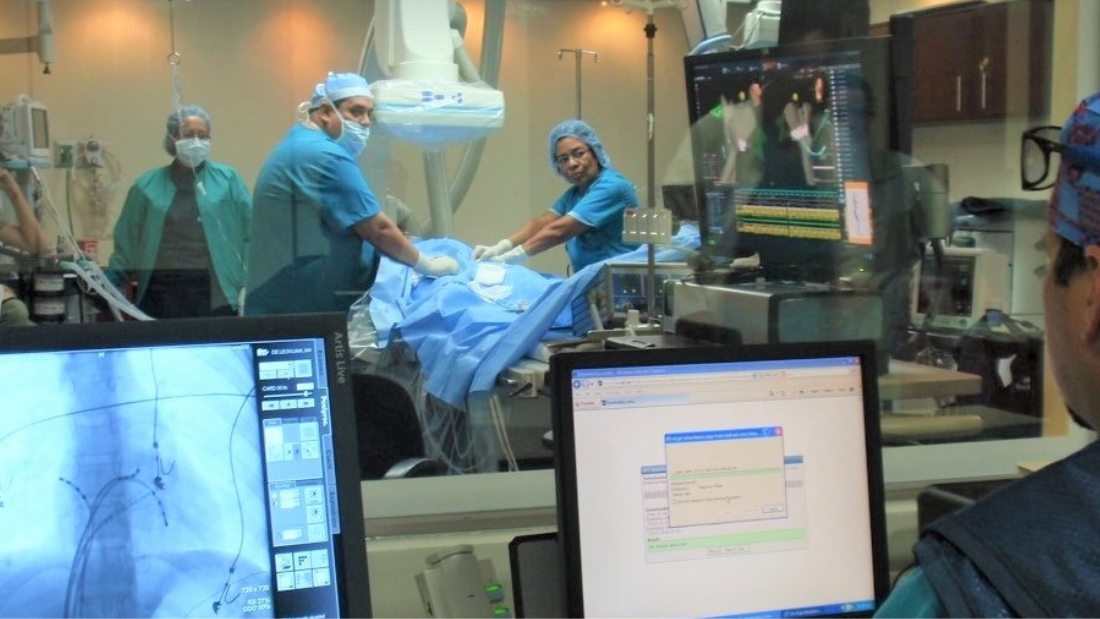Regulating the electrical rhythm of your heart
Just like the kitchen is the heart beat of your home, the blood pumped from your heart muscle delivers sustenance, stability and the elements of reconstruction to all parts of your body. Your cardiovascular system draws life-giving oxygen from the lungs and delivers it to the brain and organs in a perfectly balanced structural design. So, if the valves get stuck and the plumbing backs up or the electrical system goes haywire, all production slows or stops, and could result in disaster until professional repairs are made.
The “plumber”, or interventional cardiologist, might look for restrictions in the blood flow by initiating a cardiac catheterization. With these results, he can determine whether the vessels can be dilated by an angioplasty and supported by stents, or if a CABG (coronary artery bypass grafting) surgery is required. In other cases, the valves might need to be repaired or replaced to regulate pressure at optimum efficiency.
The “electrician”, or electro physiologist will look at the force and the rhythm of the heart to calculate an irregularity that might inhibit blood flow to the organs. He may determine that an ablation is required to destroy those malformations that are interfering with normal impulses, pressure and rhythm.
*****
On a Thursday morning in October, I was invited to observe a cardiac ablation procedure at Hospital Herrera Llerandi in Guatemala City. To treat the patient’s arrhythmia, the lead cardiologists insert various specialized wires called electrodes through the veins, and then carefully place them in predetermined areas of the heart. Together with the medical staff, they measure electrical activity to locate the origin of abnormalities and make precise corrections, by burning or altering the areas, to allow for normal electrical stimulation.
The mechanical precision with which the technical team cleared the room from a catheterization and prepared for the following procedure was astounding. No movement was incidental. Their preparations were calculated and reflexive. Every gown, glove, tube, wire and instrument remained sanitized and protected until its release was requested, to perform as required.
The patient looked at me with a contented smile as he was comfortably positioned on the operating table and sedated. Next to him, a panel of three computer monitors stands ready to follow the catheters through the vein and into the heart, in high definition and real time, with the latest software efficiency from St. Jude Medical Instruments.
The surgeons humbly explained to me that there is no director in the operating room. Every cardiologist, anesthesiologist, nurse, assistant, and technician is a valuable contributor to the operation, with a clearly defined responsibility. Each job is integral to assuring the success of the procedure.
To my inexperienced eye, their gestures seemed larger than life, effortless and dignified. With a single nod of consent, the team performed precisely with only one goal in mind, to do the best job they could for the young man on the table. I knew I was watching a sophisticated team, exuding the calm and experience that we all strive for in our professional endeavors: They make it look easy.
The time flew by, and three hours after the patient was wheeled in, the series of procedures was wrapping up and reports were recorded and printed for his file. Between the sterile protection of the face mask secured with Micropore tape, and the blue skullcap pulled tight to thwart the escape of even a single strand, Dr. Leal’s unmistakable squint and twinkle conveyed the words we all want to hear, with all sincerity: “Everything’s going to be alright”.
Neither your home nor your heart can function properly without fluidity and balance. The enemies of your long and happy life, like high stress or deteriorating mechanical systems, can be reversed only with regular monitoring and a commitment to maintaining the highest possible standards.
*******
Do you suffer from heart disease, and could you benefit from having an ablation or other potentially life-saving cardiac procedure? Will your medical insurance cover the expenses? If so, that’s great! Now tell your insurance company that you want to have the procedure performed in Guatemala ($15,000), AND you want an all-expenses-paid, one-month vacation in Central America ($2000), AND they should give you $3,000 in tax-free spending money. You might be surprised by the response because your proposal just saved the company $20,000 compared to the $40,000 that they would normally pay for these procedures in the United States. We might be onto something here.

